 |
|
Israel Journal COLLEEN TINKER |
||||
NUMBER 5 — SATURDAY, NOVEMBER 1, 2008
Tel Dan, Ceasarea Phillipi, Golan Heights, and baptism
Hi, everyone! It's truly a pleasure sharing this trip with you. Regarding Sabbath: no, sundown is not consistent. What we've read is this: Sabbath is observed from sundown on Friday until after sundown on Sabbath when three stars can be seen. For three stars to be seen, it has to be darker than mere sundown. Thus, Sabbath is generally around 25 hours long, more or less, depending on the season.
Here's today's blog; we've got limited online time, so I have to hurry myself along, here!
Greetings from Tiberias—for the last time!
Today was impacting in a very different way from yesterday’s Galilee experience. We got into our tour bus about 8:00 AM and drove north to Tel Dan. Dan is at the upper end of the region known as Galilee, and it is the area that became the capital of the northern kingdom of Israel when the nation was divided. Dan became infamous for its idolatry; King Jeroboam, hoping to eclipse the significance and the glory of Jerusalem—which was in the southern kingdom of Judah—incorporated a syncretistic religion that mixed paganism and Judaism, and he established Dan as the capital and religious headquarters of the kingdom.
God had instructed Israel that proper ritual worship was to happen only in Jerusalem where the priests and the temple were, but Jeroboam usurped God’s authority in the matter and, desiring to keep his subjects from going to Jerusalem for the feasts, he established a religious center at Dan. He set up worship to Yaweh at a pre-existing Baal high place. Jeroboam did not have his subjects actually worship a pagan deity per se; he insisted that they worshiped Yaweh, but they constructed golden calves in their temple, and they honored the pagan images.
The territory of Dan is gorgeous and very different from the rest of the arid country. The source of the Jordan River originates in Dan, and the vegetation is lush. Further, the altitude is higher—and therefore the temps are cooler—than around the Sea of Galilee. We hiked through lush vegetation to the high place at Dan. The excavation at the Dan high place reveals many layers of foundations. Generations have built high places on top of each other; the most recent layer that has been excavated dates back to Hellenistic Greek times. This pagan altar and temple/altar area stand on top of the same place Jeroboam’s Dan altar stood.
Another interesting fact about Dan is that it is situated at the very northern end of Israel, and it is very close to the Syrian and Lebanese borders. In fact, during the Six-Day’s War of the mid 60’s and the war in 1973, Israeli soldiers bunkered at Dan and fought again the Syrians. We crawled through an old Israeli bunker that dated back to the six-day’s war.
After seeing the huge high place that had been developed for pagan sacrifices and worship, we walked to one of the most amazing archeological finds of recent times. Actually, there were a couple of amazing finds. Sometime in the 90s, a Jewish archeologist discovered two things never thought about. First, he uncovered the Canaanite city gates at Dan dating from about 1,400 BC. These ancient gates had been preserved under the subsequent construction of city ramparts and armaments, and when the Canaanite gates were discovered, there were many surprises.
One of the greatest surprises was that they were constructed as three sequential gates, and they were arched. Arches, prior to the discovery of this extremely ancient artifact, were thought to have been originated by Rome, but there, still under a canopy and still being removed fully from the burying rock is the enormous gate of the city on Tel Dan, the gate it is possible that Abraham himself walked through.
Very close to the uncovered city gates is another startling find: the actual city gate and paved entrance to the city of Dan dating from the time of King Ahab. Just outside that gate the archeological team found another important thing: shards of broken pottery from a legal declaration by the king of Syria announcing his victory in a battle. In his statement he declares victory over a king of the house of David. This reference is the only extra-biblical reference yet found to prove the existence of King David.
Golan Heights
We then drove north to Ceasarea Phillipi, the place one of Herod the Great’s two surviving sons, Phillip, had erected his palace. This place was the spot where Jesus told Peter He would build his church upon the rock, and the gates of hell [or death] would not prevail against it. What most of us had ever understood, however, is that Ceasarea Phillip is another pagan high place. It housed a temple to Pan, the god of nature, and it is probable that the sacrifices to Pan included humans as well as the traditional goats. In that place of debauchery and evil, Jesus stood and declared His foundation of His church and stated that nothing would cause His church to fail. It is likely that Jesus intentionally chose Ceasarea Philippi as the location to make this announcement because by so doing, He declared in a powerful way His own authority and dominion over nature, over human authority, and over evil itself.
We began our return to the southern outlet of the Jordan River by driving through the Golan Heights. We were all amazed to find ourselves able to see the border between Israel and Syria. We could see Mt. Hermon, the source of the water for the Jordan River, and the feature that borders three nations: Israel, Syria, and Lebanon. We drove through the area where the fierce tank battles of the 1960s were fought with Syria, and we saw the war-ravaged buildings that still stand ruined. We saw Israeli army outposts with tanks and guns situated within sight of the Syrian border.
The Golan Heights are fertile, and we saw miles of farms and orchards tended by Druze villagers. The Druze are an “offshoot” of Islam, but they are not acknowledged by Islam. There are four Druze villages; the Druze are agrarian, and most of them live in the Golan Heights. Our driver, however, is a Druze whose village is near Tiberias.
We ate lunch at a small restaurant in the Golan Heights where we feasted on homemade falafels and a sort-of “wrap” that included a flat bread somewhere between a flour tortilla and pita dough spread with a delicious substance that resembled sour cream or a light cheese and served with various savory herbal dips.
Baptism
Thirteen members of our total group had chosen to be baptized in the Jordan River. Our last stop today was at an area on the Jordan prepared by a local kibbutz as a large baptismal “font”. It could accommodate several groups at once, but once Gary introduced the reason for baptism and began baptizing members of our own group, the service was instantly “church” and not merely one feature in a large event.
Two of our local FAF members, Michael and Janice Hicks, were baptized today. Michael prefaced their immersion by praising God for having called and chosen him and for giving him life in Christ. He stated that he had been baptized at the age of 16, but his baptism had been entangled with the non-biblical teachings and requirements of a false religion. He said he was choosing to be baptized today as a pure, unencumbered commitment to Jesus and that He was grateful God had revealed to him that salvation required absolutely no works from him but was all of God.
My take-home impressions from today are varied. On one hand, I was impacted by our proximity (and by Israel’s proximity) to constant political volatility and to danger. On the other hand, the impact of the ancient apostasy that continually crippled Israel was sobering. As Gary said to us today, we have to ask ourselves what idols threaten to claim the loyalty of our hearts.
At the same time, we know that the Lord Jesus has already claimed a completed victory over sin, evil, and death. He even chose to commission Peter with the promise that nothing, not even the gates of hell, will ever be able to destroy His church. He is faithful, and when our lives are hidden in Him, we are safe eternally no matter what we encounter in our lives.
Tomorrow we leave for Amman, Jordan. We will be in Jordan for three nights. We continue to appreciate your prayers, and we are praying for you as well.
Copyright 1999-2008 Graphics Studio, Redlands, CA USA. All rights reserved. Revised November 17, 2008. Use of this site and forum signifies your acceptance of the Terms and Conditions. Send comments and questions to formeradventist@gmail.com
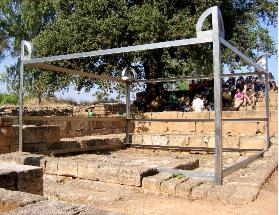
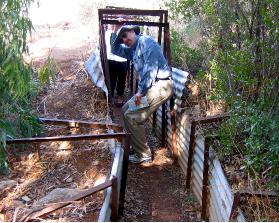
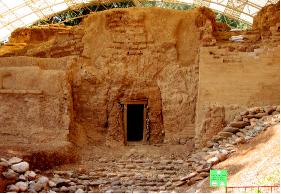 The Canaanite city gates at Tel Dan date back to the time of Abraham and feature stone arches, a building skill previously thought to have originiated with the Romans.
The Canaanite city gates at Tel Dan date back to the time of Abraham and feature stone arches, a building skill previously thought to have originiated with the Romans.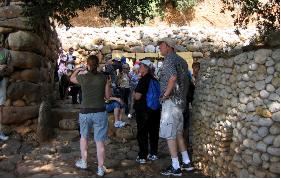 The ancient gates to the city of Dan dating from the time of King Ahab.
The ancient gates to the city of Dan dating from the time of King Ahab.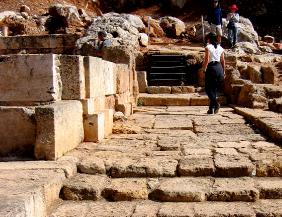 The place of pagan worship at Cesarea Phillipi included a temple to Pan, the god of nature. This is the place that Jesus declared that His church's foundation was on the Rock and the gates of hell would not be able to destroy it.
The place of pagan worship at Cesarea Phillipi included a temple to Pan, the god of nature. This is the place that Jesus declared that His church's foundation was on the Rock and the gates of hell would not be able to destroy it.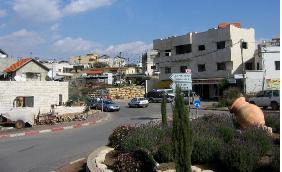 We ate our lunch in a Druze village located in the Golan Heights near the Syrian border.
We ate our lunch in a Druze village located in the Golan Heights near the Syrian border.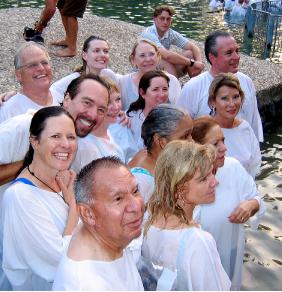 Thirteen members of our group were baptized in the Jordan River, including former Adventists Janice and Michael Hicks--the two with the biggest smiles.
Thirteen members of our group were baptized in the Jordan River, including former Adventists Janice and Michael Hicks--the two with the biggest smiles.